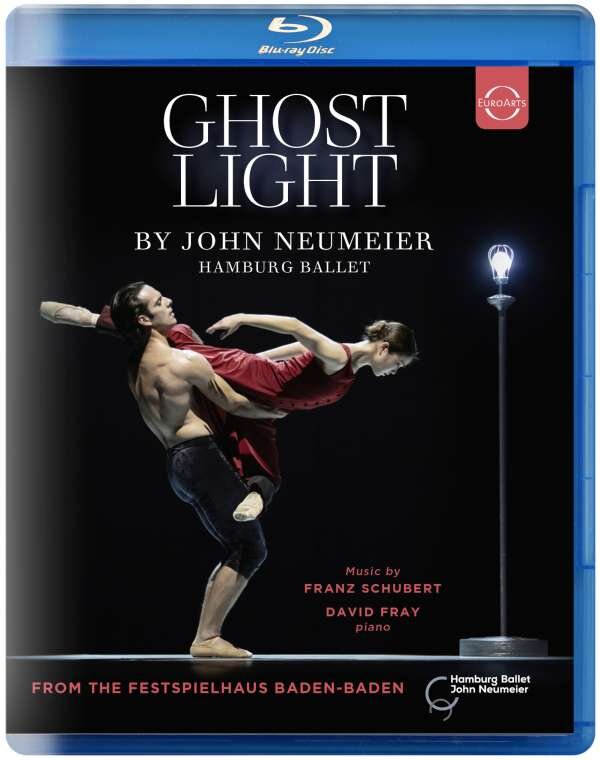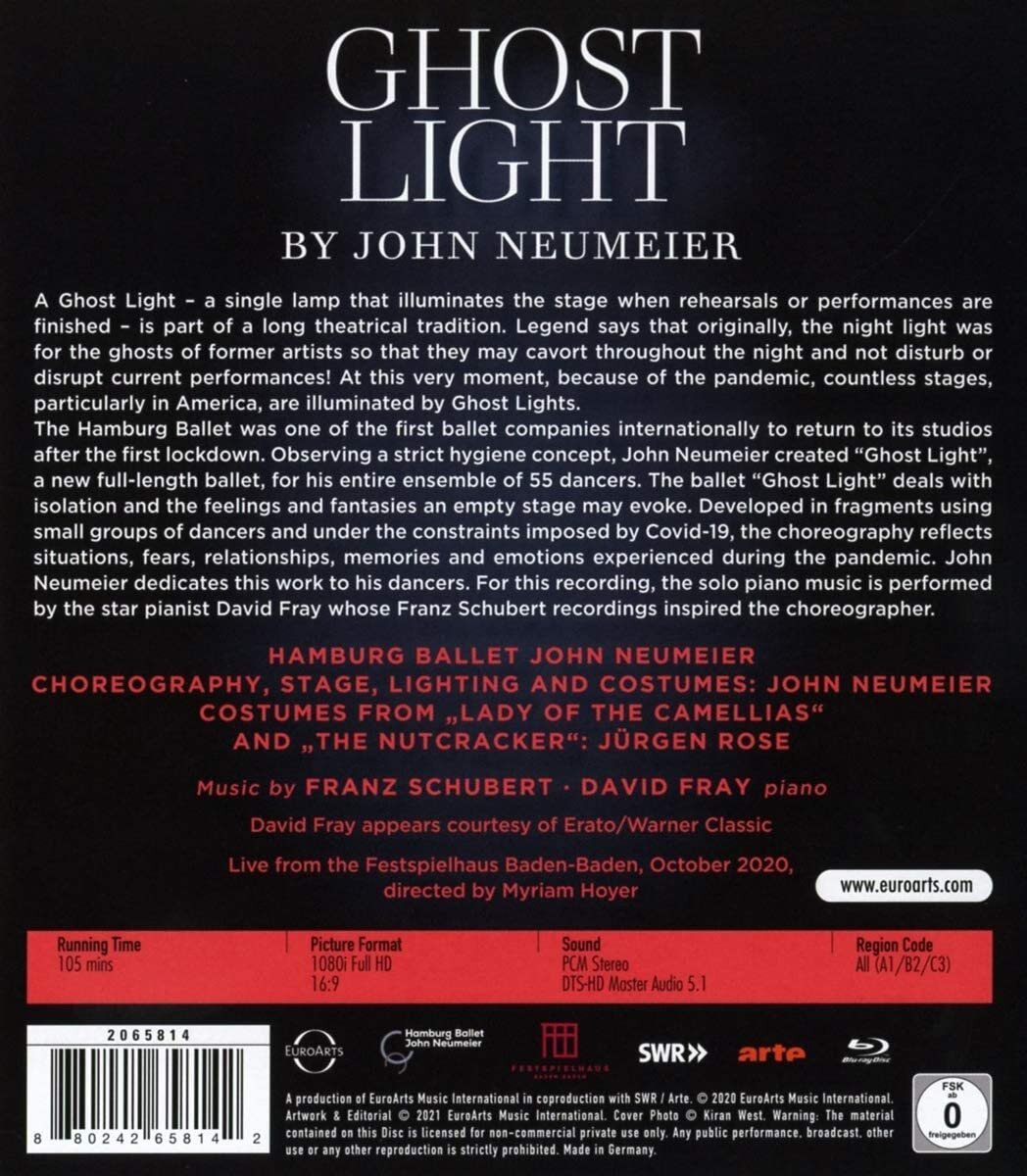

Ghost Light ballet. Choreographed 2020 by John Neumeier to solo piano music by Franz Schubert. Recorded live October 2020 at the Festspielhaus Baden-Baden. Performed by all of Neumeier’s corps (55 or so members) under physical and casting restrictions required by Covid-19 health rules. Staging, lighting, and costumes by Neumeier with Jürgen Rose costumes from Neumier’s Lady of the Camellias and The Nutcracker. Directed for TV by Myriam Hoyer. A detailed and excellent keepcase booklet has lots of information about this unique project. Released 2021, disc has 5.1 dts-HD Master Audio 5.1 sound. Grade: A+ with both the ‽ and the 💓 designations.
Let’s jump right into screen shots. First, the ghost light:
In the pandemic, just about everyone becomes a ghost. In this title the Hamburg Ballet dancers represent (1) themselves, (2) the ghosts of deceased theater artists, and finally, (3) the ghosts of Neumeier productions past. Ghosts like these perform everywhere in the world where there is a theater. But they appear only at night when the stage is dark—except for a single bulb that is customarily left on by the house to help the ghosts get home. Once they arrive, the ghosts here dance for Neumeier. (Others latched onto the Ghost Light metaphor, but Neumeier seems to have been the first.)
There is no libretto. The dancers portray their own emotions. Everyone is on board for each performance (no alternate casts). Everyone works in a no-or-low-cost mode. The music comes from a single musician, pianist David Fray. He knocks out no fewer than 12 solo Schubert piano pieces (without a break) for an hour and 46 minutes. With Fray, each piece sings and speaks in the unique voice of Schubert: 1/3 ethereal beauty, 1/3 death agony, and 1/3 forgiveness from God:
When all the others were closing theaters, Neumeier kept his dancers working and creating. Only real-life couples were cast to perform close together. Pandemic social distancing rules (2 meters in Europe) were observed for single dancers. The numerous scenes in the work were created in discrete “bubbles” before being assembled in the whole. The live audience was thinned out by social-distancing rules.
Neumeier created two dance themes he stresses in the opening segments of the show and echoes throughout. These themes link the dance bubbles into a whole. The primary theme writhes in swift, ugly arm movements of dancers expressing frustration with the pandemic. The frustration then resolves as the artists take control by forming their arms into a quiet circle. Finally, the primary theme concludes as the artists raise their arms in triumph while rotating their fists around each other. (You see the primary theme clearly in the video clip attached.) The secondary theme involves slowly raising and holding a straight leg from the hip in various directions, something you don’t often see in dance. This represents the refusal of the artists to quit.
But before the themes appear, there is a prologue as the first dancer enters: Anna Laudere as Marguerite Gautier. Marguerite is better known as La Traviata from the Verdi opera. In history she was Marie Dulpessis, a famous teen aged courtesan who died from consumption at age 23. She was also called La Dame aux Camélias, which is the title of one of Neumeier’s most famous ballets. So Marguerite was the perfect ghost to first appear. On the left below behold the beauty of her famous dress designed by Jürgen Rose. On the right below she has just had a breathing fit. She looks at her hands to see what she has coughed up:
Another famous ghost who joins the fray (pun intended) is Olivia Betteridge dressed as Giselle. The Hamburg Ballet has Giselle in repertory, but that’s not why you see her here. Giselle appears in Neumeier’s famous ballet Nijinsky, and I think that’s where this quote arises:
Next below we see Atte Kilpinen as Günther and Emilie Mazoń as Marie from the Neumeier version of The Nutcracker:
But most of the dancers are just themselves. There are a number of handsome portraits, for example, the image below of Félix Paquet:
Below Aleix Martínez and Félix Paquet in gyrations based on the pandamic themes:
There are many passages for small groups. When the dancers stay separated, it means there are no real-life couples on the stage. Next below we see Martínez again on your right joined by Christopher Evans in black and Atte Kilpinen standing next to the rear wall, all far apart:
Gradually, Neumeier adds larger formations. Below is a sextet with females Yaiza Coll, Hayley Page and Yun-Su Park dancing with Marc Jubete, Borja Bermudez, and Lizhong Wang. The men and women dance just far apart from each other to meet the German 2-meter rule (at times they briefly join for lifts, which was maybe cheating a bit). Each couple is quite far from the other pairs:
Now we turn to examples of dance couples who are actual lovers off the stage and are therefor allowed to dance closely. I was astonished how many members of the corps share intimate relationships. On reflection, I realized what a strange and isolated life professional dancers live—all the time. They work very hard from an early age on doing something that outsiders don’t easily relate to. They perform through the weekends when everybody else is relaxing. They travel a lot. They live on low wages, burn out at age 40, and then have to find new jobs. They have little job security, eat a lot of expensive food, and are constantly plagued with minor and major injuries. Where does a young dancer living like this find love? Well, among other dancers. But even in a big city, where do you find other dancers who can live with your crazy schedule? The answer is easy: in your own company. Imagine the anguish if these brave but vulnerable dancers see their company shutting down because of a virus!
In our next three screenshots, we see that Alexandre Riabko and Silvia Azzoni are a couple:
Among the many other couples in this show, the most torrid pair is David Rodriguez (below in blue) and Matias Oberlin (below in red):
Next below see four images from a duet by Nicolas Gläsmann and Madoka Sugai (this is the couple on the front cover of the keepcase):
To give everyone stage time, the junior dancers appear in small groups such as the 7 women seen below in the next two screenshots. The huge stage at Baden-Baden allowed Neumeier to maintain social distancing rules with multiple dance units on stage doing different things:
In the next screenshot below, the 9 dancers above are joined by a woman in an elegant black dress. This lady in black appears several times, and she must be a distinct character from one of Neumeier’s famous works. I can’t place the character. Can anyone ID her for me?
This show needs a long hour and 46 minutes to give everybody a part. There’s little set, two props, and no video projection. But Neumeier is a wizard with lighting, which he uses in interesting ways. For example, see the two screenshots below. Faster than the blink of an eye, the brightly lit images of Edvin Revazov and Anna Laudere turn into perfect silhouettes!
The show ends with Karen Azatyan staring at the ghost light wondering if he will survive the pandemic:
Below a well-choreographed, elegant curtain call:
I give this show the ‽ designation because it may be too long and intense for newcomers to modern abstract dancing—some of whom might find it repetitive. The repetition is what holds the work together. The viewer must focus on each dancer and his or her variations on the themes. This focus will let those who are prepared enjoy the artistry and emotions of by the dancers who bravely reach out to us—no matter what.
Ghost Light is something of an historical event when one company persisted as others quit. Further, Myriam Hoyer has given Neumeier what is probably the best video file that has been made of his productions. I ran the numbers on Hoyer. Her video pace is a fine 11.7 seconds per clip, and 80% of her images show the whole bodies of the dancers portrayed. No horrid DVDitis here. Finally, this title is a personal statement about a particular time, and it’s doubtful whether this show will stay in repertory in Hamburg. Nor is it likely that this will ever be attempted by other dance companies. So this disc could soon become a collector’s item as a unique record of a fleeting but important achievement. For all these reasons I give this an A+ grade. I also added it to our list of the best Blu-ray ballet titles and gave it my 💓.
Below is an official clip made from Myriam Hoyer’s video file:
OR



























